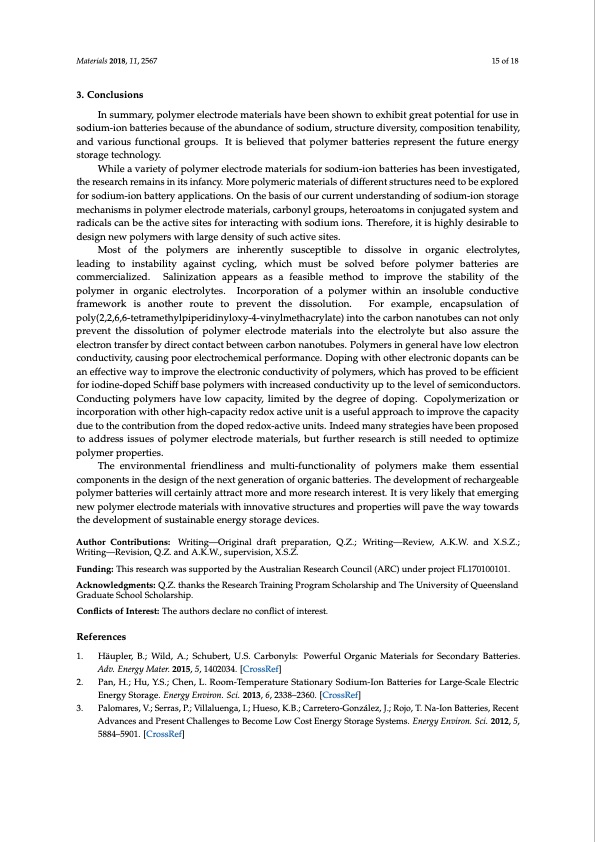
PDF Publication Title:
Text from PDF Page: 015
Materials 2018, 11, 2567 15 of 18 3. Conclusions In summary, polymer electrode materials have been shown to exhibit great potential for use in sodium-ion batteries because of the abundance of sodium, structure diversity, composition tenability, and various functional groups. It is believed that polymer batteries represent the future energy storage technology. While a variety of polymer electrode materials for sodium-ion batteries has been investigated, the research remains in its infancy. More polymeric materials of different structures need to be explored for sodium-ion battery applications. On the basis of our current understanding of sodium-ion storage mechanisms in polymer electrode materials, carbonyl groups, heteroatoms in conjugated system and radicals can be the active sites for interacting with sodium ions. Therefore, it is highly desirable to design new polymers with large density of such active sites. Most of the polymers are inherently susceptible to dissolve in organic electrolytes, leading to instability against cycling, which must be solved before polymer batteries are commercialized. Salinization appears as a feasible method to improve the stability of the polymer in organic electrolytes. Incorporation of a polymer within an insoluble conductive framework is another route to prevent the dissolution. For example, encapsulation of poly(2,2,6,6-tetramethylpiperidinyloxy-4-vinylmethacrylate) into the carbon nanotubes can not only prevent the dissolution of polymer electrode materials into the electrolyte but also assure the electron transfer by direct contact between carbon nanotubes. Polymers in general have low electron conductivity, causing poor electrochemical performance. Doping with other electronic dopants can be an effective way to improve the electronic conductivity of polymers, which has proved to be efficient for iodine-doped Schiff base polymers with increased conductivity up to the level of semiconductors. Conducting polymers have low capacity, limited by the degree of doping. Copolymerization or incorporation with other high-capacity redox active unit is a useful approach to improve the capacity due to the contribution from the doped redox-active units. Indeed many strategies have been proposed to address issues of polymer electrode materials, but further research is still needed to optimize polymer properties. The environmental friendliness and multi-functionality of polymers make them essential components in the design of the next generation of organic batteries. The development of rechargeable polymer batteries will certainly attract more and more research interest. It is very likely that emerging new polymer electrode materials with innovative structures and properties will pave the way towards the development of sustainable energy storage devices. Author Contributions: Writing—Original draft preparation, Q.Z.; Writing—Review, A.K.W. and X.S.Z.; Writing—Revision, Q.Z. and A.K.W., supervision, X.S.Z. Funding: This research was supported by the Australian Research Council (ARC) under project FL170100101. Acknowledgments: Q.Z. thanks the Research Training Program Scholarship and The University of Queensland Graduate School Scholarship. Conflicts of Interest: The authors declare no conflict of interest. References 1. Häupler, B.; Wild, A.; Schubert, U.S. Carbonyls: Powerful Organic Materials for Secondary Batteries. Adv. Energy Mater. 2015, 5, 1402034. [CrossRef] 2. Pan, H.; Hu, Y.S.; Chen, L. Room-Temperature Stationary Sodium-Ion Batteries for Large-Scale Electric Energy Storage. Energy Environ. Sci. 2013, 6, 2338–2360. [CrossRef] 3. Palomares, V.; Serras, P.; Villaluenga, I.; Hueso, K.B.; Carretero-Gonza ́lez, J.; Rojo, T. Na-Ion Batteries, Recent Advances and Present Challenges to Become Low Cost Energy Storage Systems. Energy Environ. Sci. 2012, 5, 5884–5901. [CrossRef]PDF Image | Polymer Electrode Materials for Sodium-ion Batteries

PDF Search Title:
Polymer Electrode Materials for Sodium-ion BatteriesOriginal File Name Searched:
materials-11-02567.pdfDIY PDF Search: Google It | Yahoo | Bing
Salgenx Redox Flow Battery Technology: Salt water flow battery technology with low cost and great energy density that can be used for power storage and thermal storage. Let us de-risk your production using our license. Our aqueous flow battery is less cost than Tesla Megapack and available faster. Redox flow battery. No membrane needed like with Vanadium, or Bromine. Salgenx flow battery
| CONTACT TEL: 608-238-6001 Email: greg@salgenx.com | RSS | AMP |